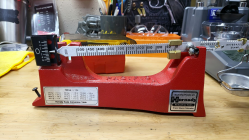Skeetman59
Silver $$ Contributor
I have 3 Chargemaster Lites and a modern 505 scale. The 505 was free. I thought I had the cat’s ass setup, LOL.Many shooters ask me questions about scales, beam scales in particular. I thought it might be useful to address some of those questions here.
Q: What is the accuracy that I can expect?
A: One half of one tenth or 1/20th of a grain for absolute accuracy in normal loading weights.
Q: What is the level of precision achievable with a beam scale.
A: I have a customer in Denton TX who has quantified this with SD of less than .02grains.
In general, I say plus or minus a kernel.
Q: What do you do to them?
A: I make them better(sorry, I'm not opening the box with the chicken bones for all to see.)
Q: What scale do you use?
A: I use a tuned Redding that is in too poor of shape to sell to anyone.
Q: What scale do you recommend?
A: An M5 if you have the scratch, a Redding or a D5 or older 502 if you are on a budget, all need tuning and calibrating.
Q: Can you tune an RCBS 505?
A: No, sorry that middle poise just doesn't allow for repeatability. It is a major design flaw. Two poise 505s work up wonderfully however.
Q: How long will it take?
A: it varies greatly. I'm one man, this is a side hobby that demands perfect focus. I'm never bugged by customers calling me. I know what it is like to wait for good stuff.
Q: Can you tune my 10-10 scale?
A: if it is American made, most likely, yes. If made elsewhere(Mexico,China) no!
Q: Will one of your scales reduce my ES and SD?
A: in most cases, yes. However, the chronograph and other loading practices must be up to the task.
In other words, dont expect my scale to make up for using mixed headstamp brass, etc.
Q: What do you think of the Dandy Auto Trickler?
A: I love mine and can't imagine how I lived without it. With it, one of my scales and a Lee powder measure($20) you have a very cost effective, high precision charging system
Scott Parker
Single Kernel Scales
VLD223@yahoo.com
661 364 1199
I check the Chargemaster with the 505 after checking the 505 with scale weights.
Looks like I need a new scale trickler. Yes I’m a newbie.












